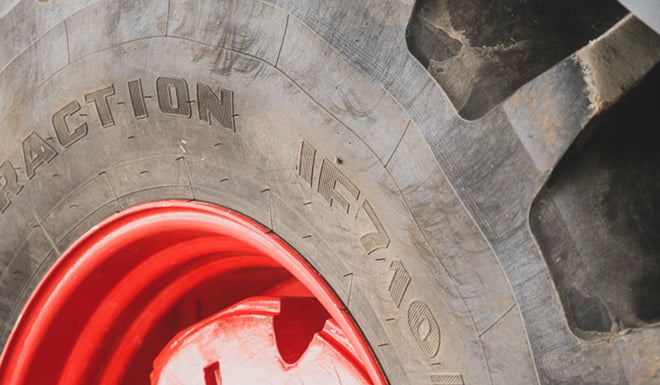Several different tyres may suit the tractor for soil preparation work.
Wide tyres or dual tyres: which equipment offers the best efficiency?
There are several advantages to using dual tyres on a tractor. Firstly, it reduces pressure to the ground. As the weight of the tractor is spread over two tyres instead of one, the pressure to the ground is effectively reduced.
Dual tyres: transmission of traction in excess of 130%
Dual mounting improves tractive force. The improved efficiency of the lugs increases transmission of engine power to the tractor. For example, a tractor with dual front and back tyres has a traction transmission capacity of over 130% (100% for a tractor with single tyres at the front and back).
A tractor with dual wheels has a lower slip ratio. This equipment also leads to a decrease in fuel consumption.
Dual mounting remains an interesting alternative in terms of compaction and as such preservation of soil structure.
However, there are some disadvantages, such as the investment cost (tyre, rims and dual mounting). Road travel is tricky and the tractor often needs to be preceded by a pilot car in order to comply with the highway code and to ensure safe driving: Tractor + dual wheels or ≤3.5 m wide tyres. Handling and set-up are complex and may require a tyre handling system such as “mani-roues’ for health and safety purposes.
For single tyres, there are three main categories of tyre on the market:
- Standard tyres
- Wide tyres
- Low-pressure/high volume tyres
All the technical information is contained in the tyre nomenclature.
For example, a standard “600/65 R 38 TL 144 B” tractor tyre classification provides the following information:
- "600" corresponds to the tyre width in mm
- "65" represents the aspect ratio (height as a percentage of width)
- "R" designates a radial tyre (see below)
- "38" corresponds to the rim diameter in inches
- "TL" means that the tyre may be tubeless
- "144 B" indicates the tyre’s maximum load capacity at a given speed e.g. 144 B = 2800 kgs at 1,6 bar (nominal pressure) for a maximum speed of 50 km/h.
There are two types of tyre construction
| DIAGONAL CONSTRUCTION BIAS-BELTED OR BIAS-PLY |
RADIAL CONSTRUCTION |
|
|---|---|---|
|
|
|
|
THE PROS |
|
|
|
THE CONS |
|
|
Learn more
Further advice is available on the essential role of the tyre by downloading the free eBook below:
Most people who read this article have also read some of the following articles:
This information is intended only to make you aware of the technical and functional aspects of agricultural tires and their use. It does not allow you to make a judgment or a definitive conclusion on a given problem. Only your agricultural tire expert is able to make a technical assessment and take a final decision, case by case.
Leave a
commentary
Your email address will not be published.
Required fields are indicated with *








